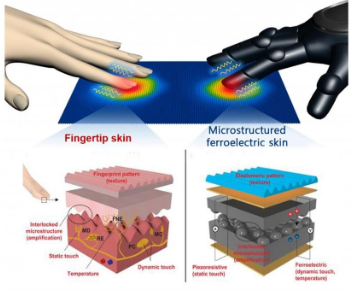PCB factory china:SMART electronic skin offers new hope for wearable medical devices
Many researchers have been keen on artificial skin technology for a long time. Although previous studies have introduced the concept of an E-skin, none has been able to detect both pressure and heat with high sensitivity. Until now, a team of South Korean researchers at the University of Science and technology (UNIST) in Ulsan has developed a new form of electronic skin that can function as human skin, the Circuit Board factory has learned. Inspired by human skin, the research team has developed a multi-mode electronic skin based on a flexible microstructure of ferroelectric thin films. The electronic skin enhances the ability to detect and identify multiple spatiotemporal tactile stimuli, such as static and dynamic pressure, temperature, and vibration.
The research was conducted by Hyunhyub Ko, a professor at the Chemical Engineering, and Heon Sang Lee, a professor at the chemical engineering in South Korea. "This is the first time in history that an electronic skin can sense so many different stimuli, " wrote Professor Hyunhyub Ko, who led the study, which was published Oct. 30 in the 30th issue of the journal Science Advances

SMART electronic skin offers new hope for wearable medical devices
As shown above, the HDI factory has learned that the electronic skin mimics the function of human skin through an elastomer pattern (texture) , piezoresistive (static pressure) , ferroelectric (dynamic pressure and temperature) and a microdome array (tactile amplification) .
In the study, Professor Ko and his team placed soft cristae membranes on plastic and graphene sheets that were as thick as several layers of cling film. When touching the electronic skin, the electrodes on the uneven surface are pressed together to allow current to flow through the device, which can then be connected to a machine that processes electrical signals. When heated, the skin also has an electric current that indicates it can detect temperature.
PCB factory china says that although the technology is still in the experimental stage, the work is a big step forward in the development of prosthetics and other wearable medical devices. This work has been supported by the National Research Foundation of Korea (NRF) , Advanced Soft Electronics Center and ICT supported by the Ministry of Science and Technology of Korea.
Other news about S&L
- Sun&Lynn Circuits CO., Ltd. was invited to attend the Sixth Global Customs AEO Conference!
- Celebrating the Establishment of SUNLYNN CIRCUITS(THAILAND)
- Good News! Sun&Lynn Circuits Co.,Ltd. is honored as one of the Top 100 Innovative Enterprises in Bao
- What Should You Know about Metal Core PCB
- FPC supplier : the types of Flexible PCB
- PCB manufacturer China:Why PCB board snake line, what is it used for?
- What is Metal Core PCB and types of Metal Core PCB?
- Why are High frequency PCBs much more expensive than normal PCBs?
- Flexible PCB supplier China :When to use flexible PCB?
- Flexible PCB manufacturer:What Is Flex Soldering?
Your browsing history
- FPC manufacturer:What is a FPC Annular Ring
- High Volume Health care PCB Assembly Benefits
- PCB supplier china:How to Clean PCBs
- Health care PCB manufacturer talk applications of Medical PCB
- PCB supplier china, Can you imagine Lao Gan Ma adds to fashion?
- Sun&Lynn Flexible PCB Supplier China Awarded Philips SSP Sliver
- PCB factory china:What Are The Advantages Of Multilayer PCBs
- FPC manufacturer advise the Advantages of a Halogen free PCB
- FPC manufacturer:North American PCB Sales Continue to Grow
- A handy VCR about flexible PCB manufacturing process flow



A total of -comments【I want to comment】